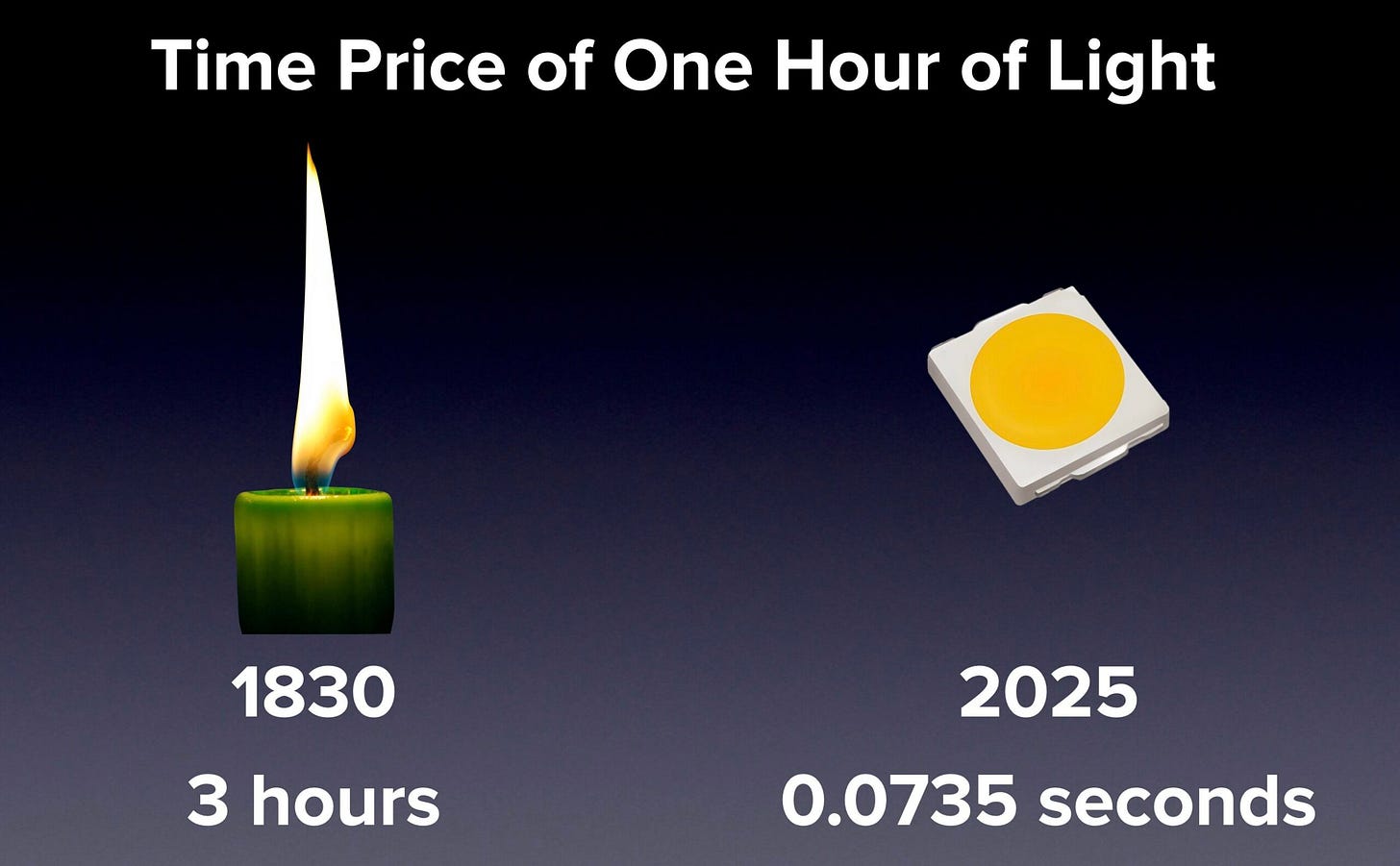Light Has Burst Forth in Astonishing Abundance
Light abundance has increased by 100,435,912 percent since 1830.
Our book Superabundance (2022) was inspired in part by the work of Nobel Prize–winning economist William Nordhaus, who conducted an extensive analysis on the “time price” of light over the span of human history. He called time prices the true prices. Light can be measured in lumens. Comfortable reading light is around 1,000 lumens. Nordhaus reported that in 1830, earning sufficient money to buy the candles necessary for one hour of light at 1,000 lumens required around three hours of labor. A candle generates around 12 lumens; therefore, one would need 83 candles to generate 1,000 lumens.
Innovation replaced candles with kerosene lamps and then with incandescent lighting and then LED lighting. Today, for 75 cents, one can buy a Cree J Series 5050C E Class LED that generates 228 lumens per watt. By increasing the wattage to 4.4 watts one can, therefore, generate 1,000 lumens of light. Electricity prices are currently around 17 cents per 1,000 watt hours, commonly known as kilowatt hours or kWh. One watt hour costs 0.017 cents; thus, the 4.4 watts to power the Cree LED for one hour would cost a mere 0.0745 cents. The average worker earns $36.53 an hour, or slightly more than a penny per second. Working for around 0.0735 seconds, therefore, the average worker earns enough money to buy 1,000 lumens for one hour.
The light that cost 10,800 seconds in 1830 costs only 0.0735 seconds today. The time price has dropped by 99.99932 percent. For the time it took to earn the money to buy 1,000 lumens for one hour in 1830, workers today earn 146,980 hours of light today. That’s a 14,697,900 percent increase. Light abundance has been increasing around 6.3 percent annually on a compound basis, doubling every 12 years.
Calculating Changes in Global Light Resources
Over the last 195 years (1830-2025), the world’s population rose from 1.2 billion to 8.2 billion—a factor of 6.83, or a 583 percent increase. To measure how humanity’s resource base has changed, we calculate the size of the global resource “pie” by multiplying personal resource abundance by population. That reveals how much “total abundance” exists across humanity at a given moment.
As we already saw, during the 195-year period, personal light abundance rose by a factor of 146,980. Assuming for argument’s sake that everyone in the world enjoys American prices of LEDs and energy, combined with the 6.83-fold increase in population, the global light abundance factor would amount to 1,004,360. In other words, the global light pie has grown by 100,435,912 percent—from an index value of 1 in 1830 to 1,004,360 today.
Light abundance would have grown at a compound annual rate of roughly 7.3 percent for almost two centuries, doubling about every 9.8 years. What was once scarce, flickering, and expensive has become nearly boundless—flowing at the speed of electrons and photons across the planet.
Resource Elasticity of Population
In economics, elasticity compares the percentage change in one variable against the percentage change in another. Between 1830 and 2025, global light resource abundance increased by 100,435,912 percent. During same period, the world’s population increased by 583 percent. Dividing 100,435,912 percent by 583 percent gives us 172,176. Every 1 percent increase in population thus corresponds to a 172,176 percent increase in global light abundance.
Let There Be More Light
We have witnessed an exponential efflorescence of light—an illumination not merely of our cities but of the human spirit itself. More people with light has meant more minds, more ideas, and more ventures into the unknown. When free to imagine and innovate, humans transform scarcity into abundance—and ignorance into insight. Over the past two centuries, we have converted the darkness of want into the radiance of wealth, beginning with light itself. From the barbarous glow of whale oil to the humble candle, and from the flicker of gas and kerosene to the steady blaze of electricity and the brilliance of silicon, each technological leap has kindled new horizons of discovery. Every advance has multiplied the possibilities for the next. The ultimate source of growth is not material—it’s the human mind set free.
The next time you turn on a light switch, please take a moment to appreciate the great work of free and creative people toiling to bring us out of the darkness. Compared to the abundant light of today’s world, our ancestors really did live in the “dark ages.”





Though the subheadline says "Light abundance has increased by 100,435,912 percent since 1830." which seems to be off by a factor of 10.
Thanks , I found this article to be both enlightening and illuminating !
There is just so much in this modern world that is "taken for granted" and not appreciated !
An amazingly rapid development in this aspect of 'human progress' !
No more 'hiding one's light beneath a bushel ' ....the talents are being allowed to shine !
As I get older I find that to read comfortably I need ever brighter lighting ,
so it has been truly serendipitous for me ! And I am really grateful.